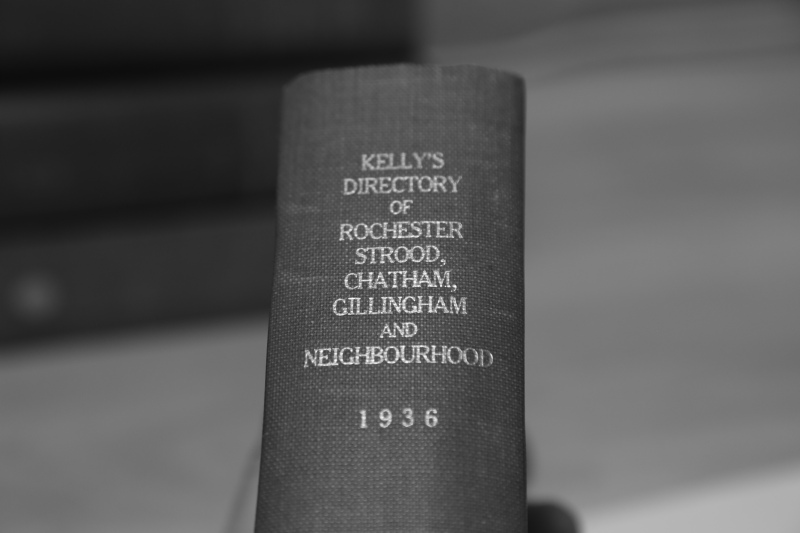I recently received a request for information about the location of Ashe House that was the residence/practice of a Doctor Drake located in Wigmore. This Dr Drake was involved in assisting at the Rainham Poison Mystery of 1931 and was in partnership with Mr. William Ulic Desmond Longford and Mr. Sven Arthur Bather.
Searching Google threw up no clues nor did checking a map of Wigmore from 1912 showing all the plots being sold off. Having drawn a blank I was doing some other family history research when I decided to check the local Kelly's Directory. This was an annual index of all residents and properties in an area so you could look up by location or by person.
I checked the 1936 edition and managed to find a Doctor Drake listed as resident at Ashe Ho, Maidstone Road, Wigmore. The only problem is that it gives no indication where Ashe House is on Maidstone Road as all houses were named not numbers. However I remembered that as well as some roads being renamed in the 1930s there was also a process of houses being numbered too so I thought a later edition may have more information.
That was a partial success! The next edition showed houses on Maidstone Road now with numbers up to 365, however Ashe house was still in a section that only contained named properties. Next step - try a later year. This time a successful match, Dr Drake was shown as living at 383 Maidstone Road Wigmore so that was the location of Ashe House!
However there is another twist! On checking the location on a map and in person it appears that number 383 no longer exists which might explain the lack of information about Ashe House. 383 appears to have been where Woodpecker Glade is now located. The numbers either side are 381 and then 385 so I'm guessing it was demolished some time in the late 1960s to make way for the Woodpecker Glade estate.
When researching something separate I spotted Ashe House listed on a Wigmore map from the 1950s which is in exactly the location shown by Woodpecker Glade above.

As with all research a few different sources and clues all came together to give an answer!
I've also received some more details about Doctor Drake from Annette in Munich who has been researching details of Dr Drake which may be of interest to anyone looking for information.
Dr. Dennys John Drake was not a "Wigmorian" by birth, but originated from London, where he passed his examinations at the Royal Colleges of Physicians and Surgeons in 1891 (1). He did not directly settle in Wigmore though. His first "call" was Assam (then part of of the Bengal Presidency, British India), where he married a Miss Helen Katherine Gill in 1902 (2). About 1910 he was again moving, this time to Leeston, New Zealand. I found some amusing stories in a local newspaper, concerning a motor cycle, damaged by straying horses, which led to a wrathful complaint of the Doctor, and his outspoken satisfaction with the "Overland Model 46", thus advertising an US-imported motor car (3).
During the Great War, Drake served in the Army Medical Service for one year (4). Whether he came back to England for this purpose, or joined an Australian regiment, and whether he returned to New Zealand after the end of his service, I don't know.
In 1927 our doctor got divorced on his wife's petition (5). Only one year later, he married a certain Gerda M. Prentice (6). My wild guess is that from around that time onwards he lived with his second wife in Ashe House.
The circumstances of his death are a bit dramatic, and actually were the starting point of my interest in his life. Though he had retired from the firm of Drake, Longford & Bather in Wigmore, in 1939 he was still active, serving as a Ship Surgeon on the HMS Devonshire. At the beginning of 1939, during the Spanish Civil War, that ship was involved in a rescue attempt. On the 8th of February (7) she transported refugees to Marseille (8), where, on the 23th of December, Dr. Drake died in a Hospital (9). Since on the day of his death the Devonshire was already back in Scapa Flow, and had sailed Marseille for the last time 6th of March (10), spring 1939 is the latest possible time of his going ashore, perhaps because he was already ill. Anyway, his absence must have caused worries at home in Wigmore. He in turn must have witnessed the outbreak of the Second World War during September 1939 in Marseille. I wonder if in those terrible times his body was brought back to England at all, and if not, where he found his final rest. But that is a different story :)
A doctor rushing in Wigmore from sick to sick on a motor cycle, or receiving them in Ashe House, probably entertaining them even with tales from his time in Assam and New Zealand: Perhaps this causes a little "ring" in the ear of Senior-Wigmorians and -Rainhamians, who would like to share their memories?
(1) "The Times", 1891-09-05, p12
(2) "The Times", 1902-12-24, p1
(3) "The Press", 1912-02-08, p3 and 1912-02-26, p2
(4) "The London Gazette",
1916-04-25 3rd suppl. p4250 and 1917-09-05 suppl p9231
(5) http://discovery.
(6)
http://www.freebmd.org.uk/cgi/
(7)
https://en.wikipedia.org/wiki/
(8) "The Times", 1939-02-14, p8
(9) "The Times", 1939-12-28, p1
(10) http://www.worldnavalships.
"The London Gazette" see https://www.thegazette.co.uk
"The Press" see https://paperspast.natlib.
"The Times" see
http://gale.cengage.co.uk/



